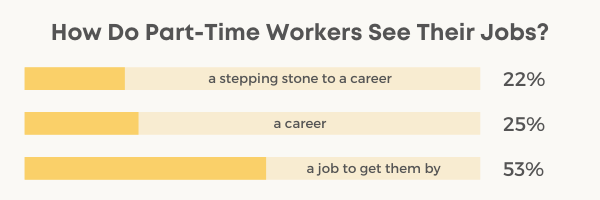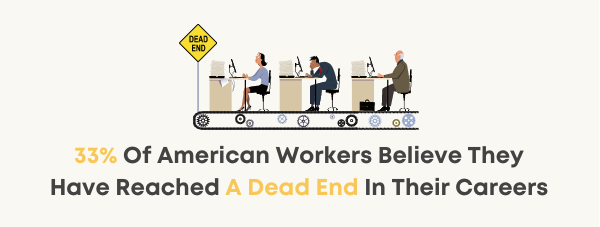For workers to be satisfied with their career, they have to feel happy about their chosen occupation and the responsibilities that come with it.
So, what percentage of workers are satisfied with their current career path?
Which careers do they consider to be happiest?
Read on to find out and be amazed!
Key Career Satisfaction Statistics (Editor’s Pick)
- 52% of American workers describe their jobs as a career.
- Only 44% of private company workers view their jobs as a career.
- Only 45% of millennials are satisfied with their career paths.
- The happiest careers are those that require no formal education.
14 Career Satisfaction Statistics
1. About half of the American workers describe their jobs as a career.
While around 52% describe their jobs as a career, 30% see their work as just a job to get them by. Moreover, 18% say that their current job is a stepping stone to a career.
Source: Pew Research Center
2. 70% of those with an undergraduate degree or more say their job is a career, compared to 44% of those with some college experience, and 39% of those with no college education.
This means that those with a bachelor’s degree or more are almost twice as likely to say that their jobs are a career, compared to those with some college experience or without a college education.
Source: Pew Research Center
3. 75% of those who have an annual family income of $75,000 or more view their jobs as a career.
While three-quarters of those with the highest annual income see their jobs as a career, less than half (49%) of those with a middle income do, too ($30,000 to $74,999). On the other hand, only 17% of those with the lowest income (under $30,000) also view their jobs as a career.
Source: Pew Research Center
4. Only 44% of those who work for private companies view their jobs as a career.
While just over four in 10 private company workers see their jobs as a career, that number rises in some other occupations. For instance, 63% of self-employed people, 66% of government workers, and 56% of those who work in non-profit organizations view their jobs as careers.
Source: Pew Research Center
5. 25% of part-time workers see their jobs as a career, compared to 53% who see it as a job to get them by.
Moreover, 22% of part-time workers see their jobs as a stepping stone to a career.
Source: Pew Research Center


6. 58% of full-time workers view their jobs as a career, while 17% say it is a stepping stone to one.
On the other hand, 24% of full-time workers say their jobs are just something they do to get them by.
Source: Pew Research Center
7. Among younger workers, they are less like to view their jobs as a career and more likely to see it as a stepping stone to one.
Compared to middle-aged and older workers, younger ones (18 to 29 years old) say their jobs are a stepping stone to a career (41%), while 29% do not view it as a career.
Source: Pew Research Center
8. Younger workers with a bachelor’s degree or more are twice as likely to view their jobs as a career.
Compared to younger workers with less education (21% of those with some college education and 22% of those with a high school diploma or less), those with a bachelor’s degree or more (41%) view their occupation as a career.
Source: Pew Research Center
9. Only 45% of millennials are satisfied with their career paths.
Less than half of millennial workers say they are satisfied with their careers. This means that the large majority of them are, in fact, dissatisfied with where their careers are going.
Source: LaSalle Network
10. One-third of workers believe they have reached a dead-end in their careers.
Not everyone knows how to take their career a step forwards, it seems. Actually, 33% of workers believe they have reached a dead-end without knowing how to develop their career past that point.
Source: Harris Interactive


11. One in five workers want to change their careers.
Around 21% of workers are dissatisfied with their careers to the point that they want to change them, according to career happiness statistics.
Source: Harris Interactive
12. The happiest careers are those that require no formal education.
According to research, it is not clear that workers with formal education are more satisfied with their work. However, it turns out that those who work in careers that require only a high school diploma are the least satisfied. Why? Because those careers are usually manual labor or service careers. Those who are the happiest with their careers are mostly in entrepreneurial and artisanal careers that do not require formal education.
Source: CareerExplorer
13. The most essential thing for the career of 37% of full-time American employees is a good work-life balance.
One of the main reasons why most workers said they love their jobs is that it gives them enough time to do the things they love outside of work. Moreover, 37% of workers identified a good work-life balance as the most important thing when it comes to their careers.
Source: Motivosity
14. The most satisfying careers are those that allow creativity and give workers control over their work.
Among the top 10 satisfying careers, workers have put CEO, Chief Executive, and Entrepreneur. Counselor is also in the top 10 careers.
Source: CareerExplorer
Final Verdict
While older workers and those with a higher annual income are more likely to view their job as a career, the happiest workers are those working in careers that require no formal education. However, career satisfaction statistics are showing that many are dissatisfied with their careers and some do not even know how to move forward, according to job satisfaction statistics.

































Find Us on Socials